You can Download Chapter 16 Digestion and Absorption Questions and Answers, 1st PUC Biology Question Bank with Answers, Karnataka State Board Solutions help you to revise complete Syllabus and score more marks in your examinations.
Karnataka 1st PUC Biology Question Bank Chapter 16 Digestion and Absorption
1st PUC Biology Digestion and Absorption NCERT Text Book Questions and Answers
Question 1.
Choose the correct answer among the following:
(a) Gastric juice contains
(i) Pepsin, lipase and rennin
(ii) Trypsin, lipase and rennin
(iii) Trypsin, pepsin and lipase
(iv) Trypsin, pepsin and renin
Answer:
(i) Pepsin, lipase and rennin
(b) Succus entericus is the name given to
(i) A junction between the ileum and large intestine
(ii) Intestinal juice
(iii) Swelling in the gut
(iv) Appendix
Answer:
(ii) Intestinal juice
![]()
Question 2.
Match column I with column II
Column I – Column II
(a) Bilirubin and biliverdin – (i) Parotid
(b) Hydrolysis of starch – (ii) Bile
(c) Digestion of fat – (iii) Lipases
(d) Salivary gland – (iv) Amylases
Answer:
(a) – ii
(b) – iv
(c) – iii
(d) – i
Question 3.
Answer briefly:
(a) Why are villi present in the intestine and not in the stomach?
Answer:
Villa are the structures which are meant to absorb food. Most of the digested food is absorbed in intestine and not in the stomach. Hence villi are present in the intestine.
(b) How does pepsinogen change Into its active form?
Answer:
The pepsinogen, on exposure to hydrochloric acid secreted in stomach, gets converted to its active enzyme form pepsin.
(c) What are the basic layers of the wall of alimentary canal?
Answer:
Serosa, muscularis, sub-mucosa and mucosa are the four layers of alimentary canal
(d) How does bile help in the digestion of fats?
Answer:
Bile helps in breaking down of fats into very small micelles which is known as emulsification. It also activates lipases which digest the fats and lipases act only on emulsified fat.
Question 4.
State the role of pancreatic juice in digestion of proteins.
Answer:
Pancreatic juice contains inactive enzymes like trypsinogen, chymctrypsinogen, procarboxypeptidases. Trypsinogen is activated by an enzyme enterokinase secreted by the intestinal mucosa into active trypsin which in turn activates other enzymes in the pancreatic juice. Proteins, proteoses and peptones in the chyme are digested by the proteolytic enzymes of pancreatic juice.

Question 5.
Describe the process of digestion of protein in stomach.
Answer:
The proenzyme pepsinogen present in the stomach gets converted to proteolytic enzyme pepsin in presence of Hydrochloric acid. Pepsin converts proteins into proteoses and peptones. Rennin is another proteolytic enzyme present in gastric juice of infants which help in digestion of milk proteins.
Question 6.
Give the dental formula of human beings.
Answer:

Question 7.
Bile juice contains no digestive enzymes, yet it is important for digestion. Why?
Answer:
Bile helps in breaking down of fats into very small micelles which is known as emulsification. It also activates lipases which act on emulsified fats and digest them. Bile also helps in stimulation, peristaltic movement, acts as a buffer and helps in lubrication of food.
Question 8.
Describe the digestive role of chymotrypsin. Which two other digestive enzymes of the same category are secreted by its source gland?
Answer:
Chymotrypsin converts proteins, peptones and proteoses into dipeptides and thus help in digestion of proteins. Other two enzymes are trypsin and carboxypeptidase.
![]()
Question 9.
How are polysaccharides and disaccharides digested?
Answer:
About 30% of starch is hydrolysed by the enzyme salivary amylase into disaccharide maltose in oral cavity.

Carbohydrates in the chyme are hydrolysed by pancreatic amylase into disaccharides. Polysaccharides (starch)

Maltase present in the intestinal juice converts maltose into glucose. Lactase converts lactose into glucose and galactose. Sucrase converts sucrose into glucose and fructose
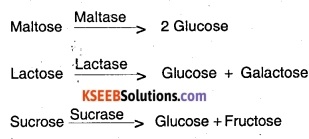
Question 10.
What would happen if HCI were not secreted in the stomach?
Answer:
HCI converts inactive pepsinogen into active pepsin. It also provides acidic medium for the action of pepsin which plays an important role in digestion of proteins. Without HCI, gastric digestion of proteins does not take place.
Question 11.
How does butter In your food get digested and absorbed in the body?
Answer:
Butter is rich in lipids. Digestion of fat starts in the stomach. The gastric lipase hydrolyses small amount of lipids. Bile helps in emulsification of fats and activates lipases which break down fats into diglycehdes and then to monoglycerides. Monoglycerides and Diglycerides are further broken down to fatty acids and glycerol in presence of lipase.

Fatty acids and glycerol being insoluble is converted to small droplets called micelles which are reformed to very small protein-coated fat globules called the chylomicrons which are absorbed by the intestine villi.
Question 12.
Discuss the main steps in the digestion of proteins as the food passes through different parts of the alimentary canal.
Answer:
There is no protein digestion in oral cavity as there are no proteases present.
Stomach: The proenzyme pepsinogen, on exposure to hydrochloric acid gets converted to active enzyme pepsin. Which converts proteins into proteoses and peptones.
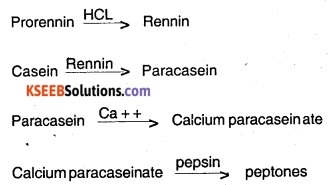
Intestine: Pancreatic juice contains inactive enzymes like trypsinogen, chymotrypsinogen and procarboxy peptidases. Trypsinogen is converted to active trypsin with the help of enzyme enterokinase. Trypsin, in turn, activates other proteolytic enzymes in the pancreatic juice. Proteins, proteoses and peptones in the intestine are now converted to dipeptides in presence of trypsin, chymotrypsin and carboxypeptidase.

The aminopeptidase hydrolyses the peptide bond that attaches the terminal amino acid to the amino end of the peptide. Dipeptidase acts on dipeptides and convert them to amino acids.
![]()
Amino acids are the end products of protein digestion.
Question 13.
Explain the term thecodont and diphyodont.
Answer:
- Each tooth is embedded in a socket of jaw bone. This type of attachment is called thecodont.
- A set of temporary milk or deciduous teeth replaced by a set of permanent or adult teeth is called diphyodont.
Question 14.
Name different types of teeth and their number in an adult human.
Answer:
Incisors – 8, canine – 4, premolars – 8, molars -12.
Question 15.
What are the functions of liver?
Answer:
- Secretion of bile
- Synthesis of blood clotting factors
- Regulating carbohydrate, protein and lipid metabolism.
- Synthesis of amino acids, plasma proteins, cholesterol etc.
- Stores glycogen, fats, fat-soluble vitamins etc.
- Detoxifies toxic substances
- Elimination of foreign bodies
- Produces heat through metabolism
- Produces anti coagulant heparin
- Synthesis of urea from ammonia.
1st PUC Biology Digestion and Absorption Additional Questions and Answers
1st PUC Biology Digestion and Absorption One Mark Questions
Question 1.
What Is digestion?
Answer:
Digestion is mechanical, enzymatic and biochemical transformation of complex (polymers) food molecules into simple molecules (monomers) which are suitable for absorption.
Question 2.
Which cells secrete HCI?
Answer:
Parietal cells.
Question 3.
What is the other name for Pancreatic amylase?
Answer:
Amylopsin
Question 4.
Which is nondigestive activating enzyme?
Answer:
Enterokinase.
Question 5.
Which glands secrete HCI?
Answer:
Gastric glands.
Question 6.
Which digestive Juice is non enzymatic?
Answer:
BWe.
Question 7.
Which gland secretes Bile?
Answer:
Liver.
Question 8.
What is cystic duct?
Answer:
Duct of gall bladder.
Question 9.
What type of muscles present on the wall stomach?
Answer:
Smooth muscles.
Question 10.
Which part of small intestine is longest?
Answer:
Ileum
Question 11.
Give an example of a vestigial organ.
Answer:
Vermiform appendix. (Oct. 83)
Question 12.
What is the ‘Pancreatic Enzyme’ which acts on starch. (Oct. 83, 01)
Answer:
The pancreatic amylase(Amylopsin).
![]()
Question 13.
Mention the function of villi. (Oct. 84)
Answer:
The Villi are structures of the intestinal wall that increase the surface of absorption i.e. their chief function is absorption
Question 14.
What is ‘Bile’? (Oct. 85)
Answer:
Bile is the juice secreted by the liver.
Question 15.
What is the mechanical action taking place in the mouth called? (Oct. 90)
Answer:
The mechanical action taking place in the mouth is known as ‘Mastication’.
Question 16.
Name a proteolytic enzyme
Answer:
Pepsin (or trypsin, chymotrypsin, carboxypeptidase Aminopeptidase, tripeptidase, dipetidase – any one can be named)
Question 17.
Name the gland which is both exo and endocrine? (April 93)
Answer:
Pancreas.
Question 18.
Mention the secretion of Goblet cells.
Answer:
Mucin (Mucus) (April 93)
Question 19.
Name the Enzyme that hydrolyses lipids.
Answer:
‘Lipases’ hydrolyse lipids. (Oct. 94)
Question 20.
Name the enzyme which does not act on the food materials in the small intestine.
Answer:
The “Enterokinase” enzyme.
Question 21.
What prevents the entry of food into the larynx during swallowing? (April 96)
Answer:
Epiglottis.
Question 22.
Which hormone causes Diabetes mellitus? (April 1996)
Answer:
The deficiency of ‘Insulin’ causes Diabetes mellitus.
Question 23.
Name the pancreatic hormone which acts as a hypoglycemic factor.(April 97, M.Q.P.)
Answer:
Insulin acts as a hypoglycemic factor.
Question 24.
Name the Carbohydrate digesting enzyme present in saliva. (Oct. 97)
Answer:
Salivary amylase or Ptyalin.
Question 25.
What is the basic mechanism of digestion in the intestine? (Oct. 88)
Answer:
‘Hydrolysis’.
Question 26.
The catalytic activity of which enzyme produces Fructose as one of the end product? (Oct. 88)
Answer:
Sucrase acts on the dissacharide sucrose resulting in a molecule of Fructose and a molecule of glucose.
Question 27.
What type of enzyme is pepsin? (Oct. 89)
Answer:
Proteolytic enzyme.
Question 28.
What Is emulsification? (Oct. 98)
Answer:
Emulsification is a process by which fats are converted to small water soluble miscles by Bile salts making them easily accessable to the action of Fats digesting enzymes called lipases.
![]()
Question 29.
Mention the function of microvilli. (April 99)
Answer:
The chief function of the microvilli is absorption (i.e., it increases the surface of absorption).
Question 30.
What Is Chyme? (April 2000, July 2010)
Answer:
The liquified and acidified food present in the stomach is called as chyme.
Question 31.
What are the end products of protein digestion? (April 2001)
Answer:
Amino acids.
Question 32.
What is Peristalsis? (Oct. 2003)
Answer:
The powerful, rhythmic waves of muscular contraction and relaxation in the walls of hollow tubular organs like the digestive tract is called peristalsis.
Question 33.
Name an enzyme present in saliva meant for killing bacteria. (July 2006)
Answer:
Lysozyme.
Question 34.
What Is succus entericus? (April 2007)
Answer:
Succus entericus is the intestinal juice made of water, mucin and 7 digestive enzymes.
Question 35.
Give reason: (July 2008)
In the absence of Enterokinase, protein digestion is incomplete.
Answer:
Enterokinase activates trypsinogen to trypsin which breaks down proteins. Hence absence of enterokinase results in nondigestion of proteins.
Question 36.
Mention two characteristic of mammalian teeth.
Answer:
Heterodont and thecodont.
Question 37.
Why are proteases generally released In – inactive form? (All India 2003)
Answer:
proteases are inactive form, they would hydrolyse the cellular and extra cellular proteins of the gut wall in the absence of food.
Question 38.
What are micelles? (All India 1998)
Answer:
The products of fat digestion are incorporated with the help of bile salts and phospholipids, into small spherical, water soluble droplets called micelles.
Question 39.
Name the passage that leads bile from the liver Into gall bladder. (Delhi 1998)
Answer:
Cystic duct.
Question 40.
Name the different parts of large intestine in humans in their natural sequence. (Delhi 1998C)
Answer:
Caecum, colon and rectum.
Question 41.
What is the number of permanent teeth in an adult human being?
Answer:
32. (Thirty two).
![]()
Question 42.
Name the two sets of teeth a human gets In his life.
Answer:
Milk teeth (deciduous teeth) and permanent teeth.
Question 43.
Name the substance that makes up the chewing surface of teeth.
Answer:
Ename
Question 44.
What are the four different types of teeth present in human?
Answer:
lncisdrs, canine, premolars and molars.
Question 45.
How many (I) molar and (II) premolar teeth are there in an adult human?
Answer:
- 12 molars
- 8 premolars.
Question 46.
Where are the taste buds located?
Answer:
Taste buds are located in the papillae on the upper surface of the tongue.
Question 47.
How is the tongue attached to the floor of the buccal cavity?
Answer:
The tongue is attached to the floor of the buccal cavity by frenulum.
Question 48.
What is the function of epiglottis?
Answer:
Epiglottis prevents the entry of food into the trachea during swallowing.
Question 49.
Name the muscular structure that regulates the movement of food from the oesphagus into the stomach.
Answer:
Gastro-Oesophageal sphincter.
Question 50.
Where is stomach located?
Answer:Answer:
Stomach is located in the upper part of the abdominal cavity on the left side, just below the diaphragm.
Question 51.
Name the three regions of the stomach in proper sequence.
Answer:
Cardiac, fundic and pyloric regions.
Question 52.
Which part of the stomach does the oesophagus enter into?
Answer:
Cardiac region.
Question 53.
Which part of the stomach continues into the duodenum?
Answer:
Pyloric region.
Question 54.
Name the three regions of human small intestine in proper sequence.
Answer:
Duodenum, jejunum and ileum.
![]()
Question 55.
Name the muscular structure that guards the opening of stomach Into duodenum.
Answer:
Mr.-Pyloric sphincter.
Question 56.
Name the part of the alimentary canal where symbiotic microbes live.
Answer:
Caecum.
Question 57.
Name the three parts of colon.
Answer:
Ascending, transverse and descending part.
Question 58.
Name any two structural features of small intestine, which helps in absorption.
Answer:
- Presence of villi
- Projections called microvilli giving brush border appearance.
Question 59.
What is the name of the major lymph vessel present in the intestinal villi?
Answer:
Lacteal.
Question 60.
Where are crypts of leiberkuhn located?
Answer:
They are located in between the bases of the villi in the intestine.
Question 61.
Name any two major glands associated with human alimentary canal.
Answer:
Pancreas, liver and the salivary glands.
Question 62.
Name the largest gland in our body.
Answer:
Liver.
Question 63.
Name the structural and functional unit of liver.
Answer:
Hepatic lobules.
Question 64.
Name the connective tissue sheath of liver lobules.
Answer:
Glisson’s capsule.
Question 65.
What are the constituents of common bile duct?
Answer:
Hepatic duct and cystic duct.
Question 66.
How does bile reach the gall bladder?
Answer:
The bile secreted by the hepatic cells passes through the hepatic ducts and enters the gall bladder through cystic duct.
Question 67.
What is sphincter of Oddi?
Answer:
Sphincter of Oddi is the muscular structure, that guards the opening of hepato-pancreatic duct into the duodenum.
![]()
Question 68.
Name one gland in human body, that secretes both digestive enzymes as well as hormones.
Answer:
Pancreas.
Question 69.
What are the two major functions of buccal cavity?
Answer:
Buccal cavity helps in mastication of food and facilitates in swallowing.
Question 70.
What is a bolus?
Answer:
When thoroughly masticated food mixes with the saliva, the food particles stick together with the help of mucus into what is known as bolus.
Question 71.
Define deglutition.
Answer:
Deglutition is the process of swallowing in which bolus is conveyed into the pharynx and then into the oesophagus.
Question 72.
In humans, starch digestion begins in the buccal cavity, but stops in stomach. Why?
Answer:
Hydrochloric acid in the gastric juice (acidic pH) inactivates the salivary amylase. Hence starch digestion stops in the stomach.
Question 73.
What is the role of intrinsic factor?
Answer:
lntrinsic factor helps in absorption of vitamin B12 from the intestine.
Question 74.
Name two enzymes which take part in the digestion of proteins in our body.
Answer:
Pepsin, trypsin, chymotrypsin and carboxypeptidase.
Question 75.
What type of medium (pH) is required for the activity of trypsin?
Answer:
Trypsin requires an alkaline pH.
Question 76.
What is the role of intrinsic factor?
Answer:
Intrinsic factor helps in absorption of vitamin B12from the intestine.
Question 77.
Name two enzymes which take part in the digestion of proteins in our body.
Answer:
Pepsin, Trypsin, Chymotrypsin and carboxy peptidase.
Question 78.
What type of medium (pH) is required for the activity of trypsin?
Answer:
Trypsin requires an alkaline pH.
![]()
Question 79.
What provides the alkaline medium for the action of trypsin in small Intestine?
Answer:
Alkaline medium is provided by bile from the liver and bicarbonates from panereas and Brunner’s glands.
Question 80.
What are peptones?
Answer:
Peptones are partially hydrolysed proteins.
Question 81.
Which is the food constituent which bile helps to digest and absorb?
Answer:
Fats.
Question 82.
Name the bile pigments?
Answer:
Bilirubin and biliverdin.
Question 83.
Name the end products of digestion of fats.
Answer:
Glycerol, fatty acids and monoglycerides.
Question 84.
Define absorption.
Answer:
Absorption is the process by which the end products of digestion pass through the intestinal mucosa into the blood or lymph.
Question 85.
Name the form in which fats enter lymph.
Answer:
Chylomicrons.
Question 86.
What are chylomicrons?
Answer:
Chylomicrons are the protein-coated, water-soluble globules of the newly synthesized fats that is combined with phospholipids and liberated into the lymph for circulation.
Question 87.
What is defaecation?
Answer:
The egestion of faeces through the anal opening is called defaecation.
Question 88.
Name the most common disorder of the alimentary system.
Answer:
Inflammation of the intestinal tract.
Question 89.
Which of the body is affected by jaundice?
Answer:
Liver.
Question 90.
What is Constipation?
Answer:
Constipation is the condition where the faeces are retained within the rectum, as the bowel movement occur irregularly.
![]()
Question 91.
What is facilitated transport?
Answer:
Some of the substances like fructose and few amino acids are absorbed by the blood with the help of carrier ions like Na+. This mechanism is called facilitated transport.
1st PUC Biology Digestion and Absorption Two Marks Questions
Question 1.
Mention the juice secreted by the liver. State its function indigestion. (April 1985)
Answer:
The liver cells secrete a juice called as the ‘Bile juice’. ‘Bile salts’ are one of the components of Bile juice. These are very important in digesting lipids or fats. Specifically ‘Bile salts’ aid in digestion than bringing about digestion of fat by emulsifying fats and making the fat molecules accessible to the action of the pancreatic Lipase (or Lipid digesting) enzyme. Apart from this the bile juice also creates an alkaline medium in the intestine so that food particles can be actively acted upon by the pancreatic enzymes. .
Question 2.
Mention any four proteolytic enzymes Involved in human digestion. (April 90)
Answer:
- Pepsin
- Trypsin
- Chymotrypsin
- Carboxypeptidase.
Question 3.
State the Role of HCI indigestion. (Oct. 88, April 93, 98)
Answer:
The main role of HCI is to convert the inactive enzyme pepsinogen to pepsin which inturn helps in digestion of proteins. It also creates an acidic medium in the stomach for the activity of pepsin.
Question 4.
Write the role of Trypsin and Chymotrypsin in protein digestion. (April 2002)
Answer:
Trypsin is secreted as trypsinogen. It is activated by the enterokinase of the intestinal juice.
![]()
Trypsin breaks down proteins into proteases, peptones & polypeptides.

polypeptides.Chymotrypsin is secreted as chymotrypsinogen. It is activated by trypsin. It too converts proteins into protein fragments, Chymotrypsinogen

Question 5.
Mention the three types of salivary glands in man and name the carbohydrate present in the saliva. (Oct. 2002)
Answer:
In man there are 3 pairs of salivary glands, they are are the parotid, Sublingual and Submaxillary glands. Saliva contains the starch splitting enzyme salivary amylase or Ptyalin.
Question 6.
Name the non-digestive enzyme found in intestinal juice. Mention its significance. (Oct. 2004)
Answer:
The non-digestive enzyme in intestinal juice is ‘E-‘nterokinase’ and helps to activate trypsinogen into trypsin which digests proteins.
![]()
Question 7.
What is succus entericus? Mention any two carbohydrate digesting enzymes present in it ? (April 2006)
Answer:
Succus entericus intestinal juice is the secretion of intestinal glands in the ileum of the small intestine. The carbohydrate digesting enzymes are maltase, lactase and sucrase.
Question 8.
Write any two roles of HCI In human digestion. (July 2010)
Answer:
The major roles played by HCI in human digestion are;
- It activates pepsinogen to pepsin which is required for protein digestion.
- It prevents decay of food in the stomach.
Question 9.
How is our gut lining protected from its own secretion?
Answer:
- Proteases are secreted in inactive form and pose no threat to the gut lining.
- The mucus and bicarbonates present in the gastric juice play an important role in the protection of the mucosal epithelium from excoriation by the highly concentrated Hydrochloric acid.
Question 10.
Name the organs which secrete carboxypeptidases and aminopeptidases respectively. Give the functions performed by these enzymes.
Answer:
Carboxypeptidases are secreted by the exocrine part of the pancreas. Aminopeptidases are secreted by intestinal mucosa. These enzymes act on the terminal peptide bonds and release the last amino acid from the polypeptide chain, thereby progressively shortening the peptide chain.
Question 11.
Amylase is secreted by two different glands. Name them what is its action on food? (Foreign 2002)
Answer:
Amylase is secreted by the salivary glands into the buccal cavity and also by pancreas.
Amylase acts on starch and breaks it into two molecules of glucose.
Question 12.
What is the site of fat digestion In humans? Name the enzymes responsible for it and mention its end products.
Answer:
Fat is mainly digested in the small intestine and very little in the stomach.
Lipase is the enzyme responsible for fat digestion. The final products of fat digestion in humans are glycerol, fatty acids and some monoglycerides.
Question 13.
Enumerate the contents of saliva.
Answer:
The saliva secreted into the oral cavity contains electrolytes like Na+, K+, Cl–, \({ HCO }_{ 3 }^{ – }\) and enzymes like salivary amylase and lysozyme. Salivary amylase helps in digesting starch and lysozyme acts as an antibacterial agent that prevents infections.
Question 14.
What is rennin? What is its function?
Answer:
- Rennin is the proteolytic enzyme found in the gastric juice of infants.
- It hydrolyses milk proteins and helps in its digestion.
Question 15.
How would it affect the digestion of proteins and carbohydrates, if there is a blockage in the pancreatic duct?
Answer:
If the pancreatic duct is blocked:
- Digestion of proteins will be impaired, as pancreatic juice contains the proteolytic enzymes trypsin, chymotrypsin and carboxypeptidase.
- Digestion of carbohydrates will stop as there will be no enzyme amylase.
- Since the bicarbonates provide an alkaline pH for the action of enzymes in the duodenum, the whole process of digestion in the intestine will be affected.
Question 16.
Give two protein-digesting enzymes of pancreatic Juice with their action.
Answer:
Pancreatic juice contains enzymes like trypsin, chymotrypsin and carboxyptidase which help in digestion of proteins.
- Trypsin acts on the proteins, proteoses and peptones and convert them into small peptides/ dipeptides
- Carboxypeptidase release the last amino acid from the peptide chain and shorten the peptide chain.
Question 17.
Name the final products of digestion of proteins. How and where are they absorbed from the alimentary canal?
Answer:
The final products of digestion of proteins are amino acids They are absorbed by active process utilising energy against the concentration gradient in the ileum.
Question 18.
Mention the Important functions of large intestine.
Answer:
- It helps in absorption of water, minerals and certain drugs.
- Secretion of mucus which helps in adhering the waste particles together and lubricating it for an easy passage.
Question 19.
Where is ileo-caecal valve present? What is its functions?
Answer:
- Ileo-caecal valve is present at the junction of ileum of small intestine and the caecum of large intestine.
- It prevents the back flow of the matter from the caecum into the ileum.
Question 20.
What Is diarrhoea? What is its consequence In nutrition?
Answer:
The abnormal frequency of bowel movement and increased liquidity of the faecal discharge is known as diarrhoea. It reduces the absorption of food.
Question 21.
Briefly explain the structure and regions of stomach.
Answer:
Stomach is a ‘J’ shaped bag like structure. A muscular sphincter called ‘gastro-oesophageal sphincter regulates the opening of oesophagus into the stomach. The stomach is located in the upper left portion of the abdominal cavity and has three major parts a cadiac portion into which the oesophagus opens, a fun dic region and a pyloric region which opens into the small intestine.
Question 22.
How Is saliva produced?
Answer:
Saliva is mainly produced by three pairs of salivary glands, the parotids (cheek), the sub-maxillary/sub-mandibular and the sub linguals. These glands are situated just outside the buccal cavity and secrete salivary juice into the buccal cavity.
Question 23.
Where is pancreas situated? Name the secretions of pancreas.
Answer:
The pancreas is a compound (both exo-crine and endrocrine) elongated organ situated between the limbs of the U shaped duodenum. The exocrine portion of pancreas secretes an alkaline pancreatic juice containing enzymes liketrypsinogen, chymotrypsinogen, procarboxy peptidases, amylases, lipases and nucleases. The endocrine portion secretes hormones, insulin and glucagon.
![]()
Question 24.
What constitutes the juice? What does it .contain?
Answer:
The secretions of the brush border cells of the mucosa along with the secretions of the gobletcells constitute the intestinal juice or succus entericus. This juice contains a variety of enzymes like disaccharidases (e.g. maltase) dipeptidases, lipases and nucleosidase.
Question 25.
How are fatty acids and glycerol absorbed into the blood?
Answer:
Fatty acids and glycerol being insoluble, cannot be absorbed into the blood. They are first inconorate into small droplets called micelles which move into the intestinal mucosa. They are re-formed into very small protein coated fat globules called the chylomicrons which are transported into the lymphy vessels in the villi. These lymph vessels ultimately release the absorbed substances into the blood stream.
Question 26.
Draw a labelled diagram of anatomical regions of human stomach.
Answer:
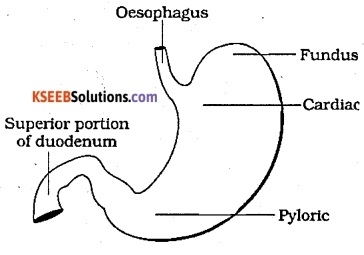
1st PUC Biology Digestion and Absorption Three Marks Questions
Question 1.
Draw a neat labelled diagram representing the duct system of liver, gall bladder and pancreas.
Answer
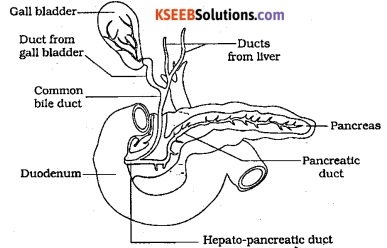
Question 2.
Name any three enzymes secreted by pancreas Specify the substrate and product of each.
Answer:
- Amylase: It acts on starch and converts it into maltose.
- Trypsin: It acts on proteins, proteoses and peptones and converts them into shorter peptides or dipeptides.
- Lipase: It acts on tiglycerides and converts them into tiglycerides and monoglycerides along with the release of fatty acids.
Question 3.
Draw a neat labelled diagram representing transverse section of gut.
Answer:
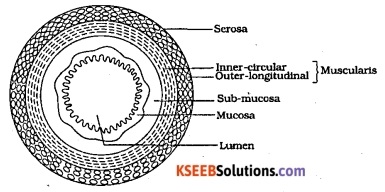
Question 4.
Write short notes on
(a) Liver
(b) Layers of the alimentary canal
Answer:
(a) Liver: Liver is the largest gland of the body. It is situated in the abdominal cavity, just below the diaphragm and has two lobes. The hepatic lobules are the structural and functional units of liver containing hepatic cells arranged in the form of cords. Each lobule is covered by a thin connective tissue sheath called the Glisson’s capsule. The bile secreted by the hepatic cells passes through the hepatic ducts and is stored and concentrated in a thin muscular sac called the gall bladder. The duct of gall bladder (Cystic duct) along with the peptic duct from the liver forms the common bile duct. The bile contains pigments like bilirubin and biliverdin, bile salts, cholesterol and phospholipids but no enzymes. Bile helps in emulsification of fats and activates lipases.
(b) Layers of the alimentary canal:
The wall of the alimentary canal possesses four layers namely serosa, muscularis, sub-mucosa and mucosa. Serosa is the outermost layer and is made up of a thin mesothelium with some connective tissues. Muscularis is formed by smooth muscles usually arranged into an inner circular and an outer longitudinal layer. An oblique muscle layer may be present in some regions.
The sub-mucosal layer is formed of loose connective tissues containing nerves, blood and lymph vessels. In duodenum, glands are also present in sub-mucosa. The innermost layer lining the lumen of the alimentary canal is the mucosa. This layer forms irregular folds in the stomach and small finger like foldings called villi in the small intestine. The cells lining the villi produce numerous microscopic projections called microvilli giving a brush border appearance.
Villi are supplied with a network of capillaries and a large lymph vessel called the lacteal. Mucosal epithelium has goblet cells which secrete mucus that help in lubrication. Mucosa also forms glands in the stomach and crypts in between the bases of villi in the intestine (crypts of lieberkuhn).
![]()
Question 5.
Draw a neat labelled diagram of a section of small intestinate mucosa showing villi.
Answer:
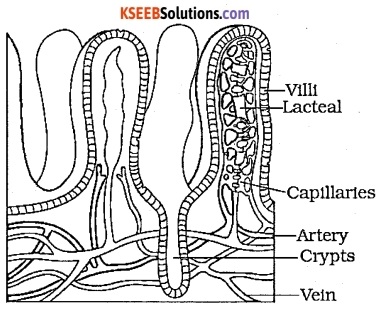
Question 6.
Which layer of the stomach contains gastric glands? Name the three types of cells present in gastric glands with their functions.
Answer:
Mucosa of the stomach has gastric glands.
Three major types of cells in gastric glands are:
- Mucus neck cells which secrete mucus
- Peptic or chief cells which secrete the proenzyme pepsinogen.
- parietal or oxyntic cells which secrete HCL and intrinsic factor essential for absorption of vitamin B12.
Question 7.
How are the nucleic acid fraction of our food digested?
Answer:
Nucleases present in the pancreatic juice convert the nucleic acids to nucleotides.
- Nucleotidases present in the pancreatic juice convert the nucleotides into nucleosides and phosphates.
- Nucleosides present in the intestinal juice convert the nucleosides into nitrogen bases and sugar.

Question 8.
Write a note on hormonal control and co-ordination of digestive parts.
Answer:
The activities of the gastro intestinal tract are under neural and hormonal control for proper co-ordination of different parts. The sight, smell or the presence of food in the oral cavity can stimulate the secretion of saliva. Gastric and intestinal secretions are also, similarly, stimulated by neural signals. The muscular activities of different parts of the alimentary canal can also be moderated by neural mechanisms, both local and through CNS. Hormonal control of the secretion of digestive juices is carried out by the local hormones produced by the gastric and intestinal mucosa.
Question 9.
Write a note on absorption in different parts of digestive system
Answer:
Mouth: Certain drugs coming in contact with the mucosa of mouth and lower side of the tongue are absorbed into the blood capillaries lining them.
Stomach: Absorption of water, simple sugars and alcohol etc. takes place in stomach. Small intestine: Principle organ for absorption of nutrients. The digestion is completed here and the final products of digestion such as glucose, fructose, fatty acids, glycerol and amino acids are absorbed through the mucosa into all blood stream and lymph.
Large Intestine: Absorption of water, some minerals and drugs takes place in large intestine.
![]()
1st PUC Biology Digestion and Absorption Five Marks Questions
Question 1.
Mention the components of human saliva. Give the function. (M.Q.P.)
Answer:
The salivary glands produce a secretion called salivary juice or saliva. It is composed
Nucleosidases of water; mucin; ions like sodium, chlorides, HCO3 etc; a bactericidal enzyme and a digestive enzyme called ptyalin or salivary amylase.
Functions of Saliva
- Moistens dry food and helps in swallowing
- Keeps mouth and teeth clean.
- Helps in tasting food
- The Salivary amylase helps in digesting the polysaccharides, starch & glycogen to maltose, a disaccharide.
- The bactericidal enzyme kills microbes and checks their load in food.
- Many substances like Iodides, lead etc are excreted through saliva.
Question 2.
Describe the digestion of carbohydrates in the small intestine. (Apr. 83, Oct. 04)
Answer:
The undigested food in terms of polysaccharides, starch and glycogen and disaccharides, sucrose & lactose (got from diet), maltose (produced from digestive action of salivary amylase on polysaccharides or those got directly as a food source) are acted upon by the carbohydrates of the pancreas and intestinal juice in the lumen of the intestine.
(i) The polysaccharides starch (plant source) and glycogen (animal source) are acted upon by the pancreatic amylase (or amylopsin) splitting them into a pool of maltose, a disaccharide.

(ii) The final pool of disaccharides produced by the action of polysaccharides (Pancreatic and salivary amylases) or those obtained directly through diet are acted upon by the di- saccharases Sucrase, Lactase and Maltase
(disaccharide splitting enzymes) of the intestinal juice in the intestinal lumen as follows, (a) Sucrose (s) are acted upon by sucrase enzyme and split into a molecule of glucose and a moecule of Fructose each.
![]()
(b) Maltose (s) are acted upon by Maltase -enzyme and split into two glucose molecules each.

(c) Lactose (s) are acted upon by Lactase enzyme and split into a molecule of glucose and galactose
![]()
Finally resulting in an absorbable pool of monosaccharides in the intestinal lumen.
Question 3.
Explain protein digestion In small Intestine? (M.Q.P., Apr. 83, Oct. 99, Mar. 2010, July 2011)
Answer:
The acid chyme released from the stomach into the intestinal lumen may contain digested protein (by pepsin) or native protein (untouched by pepsin if any) apart from carbohydrates and fats. The acid chyme is first neutralised by bicarbonates of pancreatic juice and then acted upon by various enzymes. The proteins in the chyme are acted upon by the proteolytic enzymes of the
- Pancreatic juice – namely trypsin, chymotryr.in and carboxypeptidase.
- ‘Intestinal juice – aminopeptidase, tripeptidase and dipeptidases.
Among these trypsin and chymotrypsin are endopeptidases (attacking internal peptide bonds) acting on native protein and the carboxypeptidases, aminopeptidases, tri and dipeptidases are exopeptidases (attacking superficial peptide bonds at the carbxyl end or amino end respectively) acting on protein fragments produced from whole or native proteins.
The action of the above enzymes on proteins is as follows;
(i) Trypsin and Chymotrypsin act on native proteins splitting or reducing them into shorter protein chains namely proteoses, peptones and polypeptides.

(ii) Carboxypeptidases and amino peptidases act on the protein molecules got from the digestion of native proteins converting them into tripeptides, dipeptides and amino acids.

(iii) The tri and dipeptides resulted from the above reactions are acted upon by tri and dipeptidases and split into amino acids.

Finally, resulting in a pool of amino acids which can be easily absorbed.
Question 4.
Describe the digestive process in stomach and small intestine of man. (April 84)
Answer:
Digestion in stomach: The chief organic molecules in food that are digested in the stomach are the proteins (native) and short chain simple lipids. The cells of the mucosal wall produce the gastric juice and it consists of the following enzymes apart from HCI and mucin.
- Pepsin- proteolytic enzyme(endopeptidase)
- Renin – milk curdling enzyme (Calf and infants of humans)
- Gastric lipase – acts on simple lipids. Pepsin acts on native protein molecules of food in the lumen of the stomach converting it into proteoses, peptones and polypeptides.

In Infants & calf, where the chief source of food is milk, renin is an additional enzyme which helps in curdling of milk protein casein and later this curdled casein is digested by the action of pepsin and converted to proteoses, peptones and polypeptides.
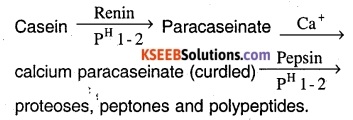
proteoses, peptones and polypeptides. Digestion in small Intestine: Two types of juices are secreted into the intestinal lumen namely the pancreatic juice and intestinal juice. Both there juices possesses enzymes digesting all types of complex organic molecules namely carbohydrates, proteins, lipids & nucleic acids.
The digestion by these enzyme in the small intestine proceeds as follows:
Carbohydrates: Polysaccharides starch (plant source) and glycogen (animal source) are acted upon by pancreatic amylase (amylopsin) in the small intestinal lumen and converted to a pool of maltose, a disaccharide.

The disaccharides, in the intestinal lumen namely maltose (obtained from digestion of polysaccharides or direct source); sucrose and Lactose (from diet) are acted upon disaccharide digesting (disaccharases) enzyme into a pool of monosaccharides, glucose, Fructose and galactose.


Proteins: The proteins reaching the small intestinal lumen are in the form of native proteins, proteoses, peptones and polypeptides. They are acted upon by following enzymes.
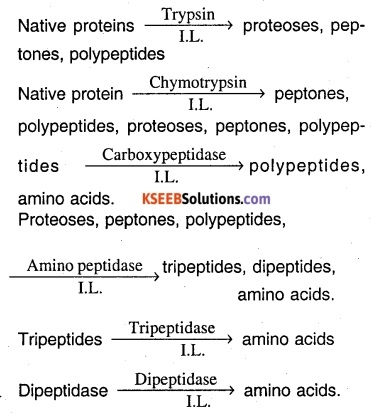
Thus resulting in a final pool of absorbable amino acids.
Lipids: The Lipids are first emulsified by bile salts in the intestinal lumen. The emulsified lipids are then worked upon by the pancreatic lipase to a pool of glycerol, fatty acids and monoglycerides.

Fattyacids, monoglycerides
Nucleic acids: Nucleases from the pancreas” acts upon the RNA & DNA nucleic acids breaking them into nucleotides and these nucleotides are later acted upon by nucleotidases & nucleosidases of the intestinal juice.
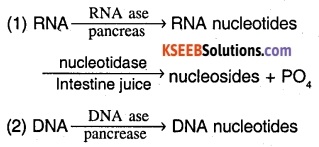

deoxyribose sugar; ribose sugar; nucleic acid bases.
![]()
Question 5.
Mention two enzymes present in pancreatic juice? Explain their role In the intestinal digestion. (April 86)
Answer:
The acid chyme released from the stomach into the intestinal lumen may contain digested protein (by pepsin) or native protein (untouched by pepsin if any) apart from carbohydrates and fats. The acid chyme is first neutralised by bicarbonates of pancreatic juice and then acted upon by various enzymes. The proteins in the chyme are acted upon by the proteolytic enzymes of the
- Pancreatic juice – namely trypsin, chymotryr.in and carboxypeptidase.
- ‘Intestinal juice – aminopeptidase, tripeptidase and dipeptidases.
Among these trypsin and chymotrypsin are endopeptidases (attacking internal peptide bonds) acting on native protein and the carboxypeptidases, aminopeptidases, tri and dipeptidases are exopeptidases (attacking superficial peptide bonds at the carbxyl end or amino end respectively) acting on protein fragments produced from whole or native proteins.
The action of the above enzymes on proteins is as follows;
(i) Trypsin and Chymotrypsin act on native proteins splitting or reducing them into shorter protein chains namely proteoses, peptones and polypeptides.

(ii) Carboxypeptidases and amino peptidases act on the protein molecules got from the digestion of native proteins converting them into tripeptides, dipeptides and amino acids.

(iii) The tri and dipeptides resulted from the above reactions are acted upon by tri and dipeptidases and split into amino acids.

Finally, resulting in a pool of amino acids which can be easily absorbed.
Question 6.
Explain digestion of food in small intestine by the enzymes of intestinal glands. (Oct. 87)
Answer:
The secretion produced by the intestinal glands is known as the intestinal juice or succus entricus. It is a clear yellow fluid with a pH around 7.6 and contains water, mucous and some digestive enzymes produced by intestinal cells. The enzymes found in the intestinal juice and their action is as follows on food in the small intestine.
(1) Carbohydrases: Maltase, Lactase, Sucrase these are disaccharases digesting disaccharides Maltose, Lactose and sucrose in the intestinal lumen as follows at pH 7.1 – 8.2.
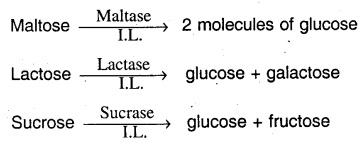
(2) Proteases: Aminopeptidase, tripeptidase and dipeptidase-(Exopeptdases) these are proteolytic enzymes digesting the intermediate polypeptides produced by the action of endopeptidases of stomach & pancreas. Their action is as follows in the small intestinal at pH 7.1 – 8.2
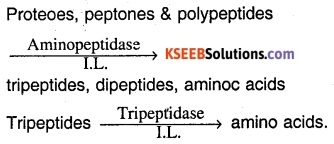
![]()
(Enterokinase, an activator enzyme, activates gastric glands to produce gastric juice)
(3) Lipase: A fat digesting enzyme. It is not as strong as pancreatic lipase but it completes digestion of fat in the small intestinal lumen.
(4) Nucleases: Act on nucleoside molecules of nucleoproteins, splitting them into corresponding nitrogenous bases and sugar molecule.
Question 7.
Explain the role of pancreas in the process of digestion. (Oct. 87, 88)
Answer:
Pancreas is a dual gland composed of two portions, an exocrine portion having cells producing enzymes required for digestion of food and Endocrine portion having groups of cells producing hormones required for metabolism and homeostasis.
As a digestive gland it plays a very important role in the process of digestion by possessing the most potent or powerful enzymes required for digestion of all types of food molecules namely carbohydrates, proteins, fats and nucleic acids.
The pancreatic juice secreted by the pancreatic exocrine glands reaches the intestine through the pancreatic duct (duct of wirsung) which usually joins the bile duct before opening into the first part of the duodenum. It is a clear, colourless liquid, containing some salts and sodium bicarbonate apart form enzymes.
As soon as food enters duodenum, a series of neurogenic and hormonal mechanism’s come into play and maintain a steady secretion of these fluids into the duodenum. These secretions mix with the acid chyme released from the stomach’ in the duodenum. The salts and bicarbonates neutralise and alkalize the acid chyme whereas the enzymes work upon the complex food molecules converting them into smaller molecules which are later on acted upon by intestinal juice enzymes converting them into absorbable forms.
The pancreatic digestive action can be summarized as follows :
(1) Carbohydrases (carbohydrate splitting): Pancreatic amylase acts on polysaccharides starch (plant origin) and glycogen (animal origin) converting these into disaccharide molecules, namely maltose.
(2) Proteases (Protein-splitting):
- Trypsin, Chymotrypsin (Endopeptidases) act on native proteins splitting them into pro-teoses, peptones and polypeptide molecules.
- Carboxypeptidase (exopeptidase) act on proteins, peptones and polypeptides splitting them into tripeptides, dipeptides and amino acids.
(3) Pancreatic lipase: act on fats emulsified by brie salts splitting them into glycerol, fattyacids and monoglycerides.
(4) Nucleases: Ribonuclease and deoxyrib-onucleases – splitting nucleic acids (RNA & DNA) into simple nucleotides of respective types. These are later acted upon by nucle-otidases, splitting them into nucleosides of RNA & DNA and PO
Question 8.
Explain how carbohydrates and protein are digested by the intestinal juice. (Oct. 90)
Answer:
The undigested food in terms of polysaccharides, starch and glycogen and disaccharides, sucrose & lactose (got from diet), maltose (produced from digestive action of salivary amylase on polysaccharides or those got directly as a food source) are acted upon by the carbohydrates of the pancreas and intestinal juice in the lumen of the intestine.
(i) The polysaccharides starch (plant source) and glycogen (animal source) are acted upon by the pancreatic amylase (or amylopsin) splitting them into a pool of maltose, a disaccharide.

(ii) The final pool of disaccharides produced by the action of polysaccharides (Pancreatic and salivary amylases) or those obtained directly through diet are acted upon by the di- saccharases Sucrase, Lactase and Maltase
(disaccharide splitting enzymes) of the intestinal juice in the intestinal lumen as follows, (a) Sucrose (s) are acted upon by sucrase enzyme and split into a molecule of glucose and a moecule of Fructose each.
![]()
(b) Maltose (s) are acted upon by Maltase -enzyme and split into two glucose molecules each.

(c) Lactose (s) are acted upon by Lactase enzyme and split into a molecule of glucose and galactose
![]()
Finally resulting in an absorbable pool of monosaccharides in the intestinal lumen.
The acid chyme released from the stomach into the intestinal lumen may contain digested protein (by pepsin) or native protein (untouched by pepsin if any) apart from carbohydrates and fats. The acid chyme is first neutralised by bicarbonates of pancreatic juice and then acted upon by various enzymes. The proteins in the chyme are acted upon by the proteolytic enzymes of the
- Pancreatic juice – namely trypsin, chymotryr.in and carboxypeptidase.
- ‘Intestinal juice – aminopeptidase, tripeptidase and dipeptidases.
Among these trypsin and chymotrypsin are endopeptidases (attacking internal peptide bonds) acting on native protein and the carboxypeptidases, aminopeptidases, tri and dipeptidases are exopeptidases (attacking superficial peptide bonds at the carbxyl end or amino end respectively) acting on protein fragments produced from whole or native proteins.
The action of the above enzymes on proteins is as follows;
(i) Trypsin and Chymotrypsin act on native proteins splitting or reducing them into shorter protein chains namely proteoses, peptones and polypeptides.

(ii) Carboxypeptidases and amino peptidases act on the protein molecules got from the digestion of native proteins converting them into tripeptides, dipeptides and amino acids.

(iii) The tri and dipeptides resulted from the above reactions are acted upon by tri and dipeptidases and split into amino acids.

Finally, resulting in a pool of amino acids which can be easily absorbed.
Question 9.
Explain the Digestion of protein In human digestive system. (Oct. 92)
Answer:
Digestion in stomach: The chief organic molecules in food that are digested in the stomach are the proteins (native) and short chain simple lipids. The cells of the mucosal wall produce the gastric juice and it consists of the following enzymes apart from HCI and mucin.
- Pepsin- proteolytic enzyme(endopeptidase)
- Renin – milk curdling enzyme (Calf and infants of humans)
- Gastric lipase – acts on simple lipids. Pepsin acts on native protein molecules of food in the lumen of the stomach converting it into proteoses, peptones and polypeptides.

In Infants & calf, where the chief source of food is milk, renin is an additional enzyme which helps in curdling of milk protein casein and later this curdled casein is digested by the action of pepsin and converted to proteoses, peptones and polypeptides.
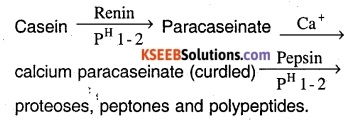
proteoses, peptones and polypeptides. Digestion in small Intestine: Two types of juices are secreted into the intestinal lumen namely the pancreatic juice and intestinal juice. Both there juices possesses enzymes digesting all types of complex organic molecules namely carbohydrates, proteins, lipids & nucleic acids.
The digestion by these enzyme in the small intestine proceeds as follows:
Carbohydrates: Polysaccharides starch (plant source) and glycogen (animal source) are acted upon by pancreatic amylase (amylopsin) in the small intestinal lumen and converted to a pool of maltose, a disaccharide.

The disaccharides, in the intestinal lumen namely maltose (obtained from digestion of polysaccharides or direct source); sucrose and Lactose (from diet) are acted upon disaccharide digesting (disaccharases) enzyme into a pool of monosaccharides, glucose, Fructose and galactose.


Proteins: The proteins reaching the small intestinal lumen are in the form of native proteins, proteoses, peptones and polypeptides. They are acted upon by following enzymes.
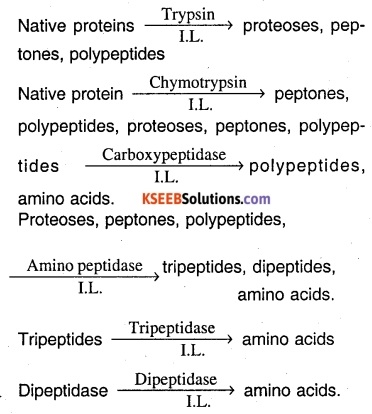
Thus resulting in a final pool of absorbable amino acids.
Lipids: The Lipids are first emulsified by bile salts in the intestinal lumen. The emulsified lipids are then worked upon by the pancreatic lipase to a pool of glycerol, fatty acids and monoglycerides.

Fattyacids, monoglycerides
Nucleic acids: Nucleases from the pancreas” acts upon the RNA & DNA nucleic acids breaking them into nucleotides and these nucleotides are later acted upon by nucleotidases & nucleosidases of the intestinal juice.
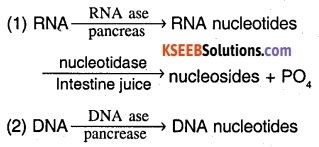

deoxyribose sugar; ribose sugar; nucleic acid bases.
(ii) The acid chyme released from the stomach into the intestinal lumen may contain digested protein (by pepsin) or native protein (untouched by pepsin if any) apart from carbohydrates and fats. The acid chyme is first neutralised by bicarbonates of pancreatic juice and then acted upon by various enzymes. The proteins in the chyme are acted upon by the proteolytic enzymes of the
- Pancreatic juice – namely trypsin, chymotryr.in and carboxypeptidase.
- ‘Intestinal juice – aminopeptidase, tripeptidase and dipeptidases.
Among these trypsin and chymotrypsin are endopeptidases (attacking internal peptide bonds) acting on native protein and the carboxypeptidases, aminopeptidases, tri and dipeptidases are exopeptidases (attacking superficial peptide bonds at the carbxyl end or amino end respectively) acting on protein fragments produced from whole or native proteins.
The action of the above enzymes on proteins is as follows;
(i) Trypsin and Chymotrypsin act on native proteins splitting or reducing them into shorter protein chains namely proteoses, peptones and polypeptides.

(ii) Carboxypeptidases and amino peptidases act on the protein molecules got from the digestion of native proteins converting them into tripeptides, dipeptides and amino acids.

(iii) The tri and dipeptides resulted from the above reactions are acted upon by tri and dipeptidases and split into amino acids.

Finally, resulting in a pool of amino acids which can be easily absorbed.
Question 10.
What is digestion? Explain the physiology of digestion of carbohydrate and protein In the small ‘intestine. (Oct. 94, March 2011)
Answer:
Digestion is a process by which complex organic food molecules are broken down or hydrolysed into simple (or small) absorbable forms by the action of digestive enzymes.
The undigested food in terms of polysaccharides, starch and glycogen and disaccharides, sucrose & lactose (got from diet), maltose (produced from digestive action of salivary amylase on polysaccharides or those got directly as a food source) are acted upon by the carbohydrates of the pancreas and intestinal juice in the lumen of the intestine.
(i) The polysaccharides starch (plant source) and glycogen (animal source) are acted upon by the pancreatic amylase (or amylopsin) splitting them into a pool of maltose, a disaccharide.

(ii) The final pool of disaccharides produced by the action of polysaccharides (Pancreatic and salivary amylases) or those obtained directly through diet are acted upon by the di- saccharases Sucrase, Lactase and Maltase
(disaccharide splitting enzymes) of the intestinal juice in the intestinal lumen as follows, (a) Sucrose (s) are acted upon by sucrase enzyme and split into a molecule of glucose and a moecule of Fructose each.
![]()
(b) Maltose (s) are acted upon by Maltase -enzyme and split into two glucose molecules each.

(c) Lactose (s) are acted upon by Lactase enzyme and split into a molecule of glucose and galactose
![]()
Finally resulting in an absorbable pool of monosaccharides in the intestinal lumen.
The acid chyme released from the stomach into the intestinal lumen may contain digested protein (by pepsin) or native protein (untouched by pepsin if any) apart from carbohydrates and fats. The acid chyme is first neutralised by bicarbonates of pancreatic juice and then acted upon by various enzymes. The proteins in the chyme are acted upon by the proteolytic enzymes of the
- Pancreatic juice – namely trypsin, chymotryr.in and carboxypeptidase.
- ‘Intestinal juice – aminopeptidase, tripeptidase and dipeptidases.
Among these trypsin and chymotrypsin are endopeptidases (attacking internal peptide bonds) acting on native protein and the carboxypeptidases, aminopeptidases, tri and dipeptidases are exopeptidases (attacking superficial peptide bonds at the carbxyl end or amino end respectively) acting on protein fragments produced from whole or native proteins.
The action of the above enzymes on proteins is as follows;
(i) Trypsin and Chymotrypsin act on native proteins splitting or reducing them into shorter protein chains namely proteoses, peptones and polypeptides.

(ii) Carboxypeptidases and amino peptidases act on the protein molecules got from the digestion of native proteins converting them into tripeptides, dipeptides and amino acids.

(iii) The tri and dipeptides resulted from the above reactions are acted upon by tri and dipeptidases and split into amino acids.

Finally, resulting in a pool of amino acids which can be easily absorbed.
![]()
Question 11.
Give an account of the digestion of proteins in man. (Oct. 2001)
Answer:
Protein digestion in man:
(a) Protein digestion in the mouth: Proteins do not undergo any change as there is no protease in the mouth.
(b) Protein digestion in the stomach: Gastric juice has two proteases pepsin and rennin.
(i) Pepsin is first secreted as pepsinogen: It is converted to pepsin by HCI. One HCI has converted some pepsinogen, further conversion is autocatalytic. Pepsin is an endopeptidase. It acts on internally situated peptide bonds of proteins. In the end the proteins are converted to proteoses, peptones and polypeptides.

(ii) Rennin (also called chymosin): It is a milk curdling enzyme that is mostly present in infants. It is secreted as prorennin. Renin acts on the soluble milk protein, casein, converting it into paracasein. In the presence of Ca2+ of milk it is further converted into calcium para caseinate, which coagulates preventing the rapid passage of milk into the duodenum. It is then hydrolyzed by pepsin to proteoses, peptones & polypeptides
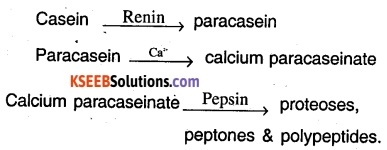
As digestion proceeds in the stomach the food becomes more or less liquified and is referred to as chyme.
(c) Protein digestion in the Intestine: Here it comes under the action of
(i) Pancreatic proteases &
(ii) Intestinal proteases.
(i) Pancreatic proteases: These are Trypsin, chymotrypsin and carboxypeptidase. The first two are endopeptidases and the third is and exopeptidase. Trypsin is secreted as trypsinogen & it is activated by enterokinase (enteropeptidase) of the intestinal juice.
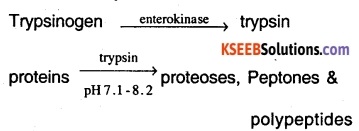
chymotrypsinogen which is activated by trypsin. It, too, converts proteins into protein fragments.

Carboxypeptidase an enopeptidase, hydrolyzes terminally situated bonds. The products are tripeptides, Depeptides and amino acids.

(ii) Intestinal proteases: They may be termed as peptidases because they act on the protein fragments. Proteoses, peptones and polypeptides ammopeptidase tripeptides, dipeptides and

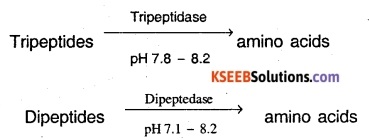
The proteins have been completed digested and the products are free amino acids. They are now ready to be absorbed.
Question 12.
Draw a neat labelled diagram of the human alimentary canal. (M.Q.P.)
OR
Draw a neat labelled diagram of digestive
Answer:
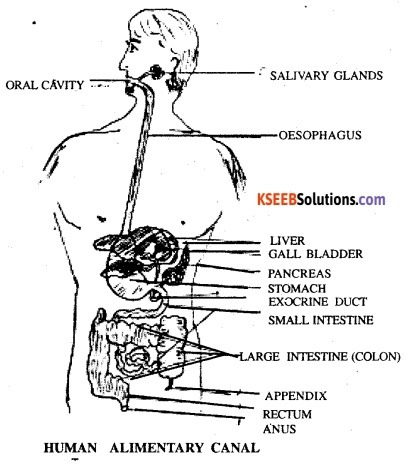
Question 13.
Write the functions of intestinal juice.
Answer:
- Intestinal mucus protects the intestinal epithelia.
- Disaccharidases like maltase, lactase and sucrase bring complete hydrolysis of disaccharides into monosaccharides (see carbohydrate digestion).
- Aminopeptidases hydrolyse peptides of different length into amino acids.
- Dipeptidase hydrolyse dipeptides into amino acids, (see protein digestion).
- Nucleotidase and Nucleosidase hydrolyse Nucleotides and convert them into purines, pyrimidine and inorganic phosphate.
![]()
Question 14.
Describe the process of Lipid digestion in small intestine of man. (Oct. 2004)
Answer:
Fats or lipids mainly contain triglycerides i.e. consists of 3 fatty acid molecules attached to a molecule of glycerol. The major fat-digesting enzyme is pancreatic lipase.
The fats are first emulsified i.e. the bile salts combine with fats and break them down into small droplets which form a soapy mixture. The small droplets are acted by lipase which breaks them into fatty acids, glycerol, mono and diglycerides.

The bile salts then combine with the products and form water-soluble complexes which are absorbed.
Question 15.
Briefly explain the disorders of digestive system.
Answer:
The disorder of digestive system are:-
- The inflammation of the intestinal tract is the most common ailment due to bacterial or viral infections. The infections are also caused by the parasites of the intestine like tapeworm, roundworm, threadworm, hookworm, pin worm etc.
- Jaundice:- The liver is affected, skin and eyes turn yellow due to the deposit of bile pigments.
- Vomiting: It is the ejection of stomach contents through the mouth. This reflex action is controlled by the vomit centre in the medulla. A feeling of nausea precedes vomiting.
- Diarrhoea: The abnormal frequency of bowel movement and increased liquidity of the faecet discharge is known as diarrhoea. It reduces the absorption of food.
- Constipation: In constipation, the faeces are retained with the rectum as the bowel movements occur irregularly.
- Indigestion: In this condition, the food is not properly digested leading to a feeling of fullness. The causes of indigestion are inadequate enzyme secretion, anxiety food poisoning, over eating and spicy food.
Question 16.
Fill in the blanks.
(a) The type of dentition in humans is called ……………..
(b) ……………..has …………….. cells which secrete mucus that help In lubrication.
(c) Each lobule of liver is covered by a thin connective tissue sheath called ……………..
(d) Hepate pancreatic duct is guarded by ……………..
(e) Alcohol is absorbed in ……………..
Answer:
(a) Diphyodont
(b) Mucosal epithilium, goblet cells
(c) Glisson’s capsule
(d) Sphincter of Oddi
(e) Stomach.
Question 17.
Match the following:
(a) Trypslnogen – (i) Goblet cells
(b) Saliva – (ii) Oxyntic cells
(c) HCL- (iii) Pancreas
(d) Pepsinogen – (iv) Parotids
(e) Mucus – (v) Chief cells
Answer:
(a) → (iii)
(b) → (iv)
(c) → (ii)
(d)→ (v)
(e) → (i)